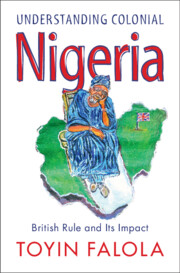Book contents
- Understanding Colonial Nigeria
- Understanding Colonial Nigeria
- Copyright page
- Dedication
- Contents
- Figures
- Maps
- Preface
- Acknowledgments
- Timeline of Events
- Part I Introduction
- Part II Conquest and Colonization
- Part III Colonial Societies
- 8 World War I and Its Aftermath
- 9 The Interwar Years
- 10 Indirect Rule and the Native Administration
- 11 The Legal System and Law Enforcement
- 12 Colonial Economy
- 13 Western Education
- 14 Social Changes
- 15 Women
- 16 Religions
- 17 Health and Medicine
- 18 Cultures
- 19 Urbanization
- 20 Creativity and Aesthetics
- Part IV Nationalism and Independence
- Part V Conclusion
- Bibliography
- Index
20 - Creativity and Aesthetics
from Part III - Colonial Societies
Published online by Cambridge University Press: 21 November 2024
- Understanding Colonial Nigeria
- Understanding Colonial Nigeria
- Copyright page
- Dedication
- Contents
- Figures
- Maps
- Preface
- Acknowledgments
- Timeline of Events
- Part I Introduction
- Part II Conquest and Colonization
- Part III Colonial Societies
- 8 World War I and Its Aftermath
- 9 The Interwar Years
- 10 Indirect Rule and the Native Administration
- 11 The Legal System and Law Enforcement
- 12 Colonial Economy
- 13 Western Education
- 14 Social Changes
- 15 Women
- 16 Religions
- 17 Health and Medicine
- 18 Cultures
- 19 Urbanization
- 20 Creativity and Aesthetics
- Part IV Nationalism and Independence
- Part V Conclusion
- Bibliography
- Index
Summary
This chapter analyses the historical evolution of the creation and aesthetics of Nigerian artists during the colonial period through local musicians and actors. Moreover, the importance of oral traditions before the interaction with Europeans – such as proverbs, panegyrics, and rituals – incorporated Christianity through schools by the Nigerian elite and Western music and instruments. In the case of music, the chapter mentions how precolonial cultural traditions shaped it, the influence of ex-enslaved people from the Caribbean (such as Brazilians) who returned to the city of Lagos, and European contributions. Methodologically, the chapter follows musicians such as Fela Sowande, Victor Olaiya, and Bobby Benson. They, in different ways, integrated precolonial elements to create a national tradition that would create unity in the colonial period. In the case of theater, the chapter also mentions its historical evolution: from traveling theater to the work of Hubert Ogunde, Kola Ogunmola, and Duro Ladipo, as icons representing creativity and aesthetics, introducing Nigerian cultural elements to theater, such as Yoruba, Hausa, and Igbo language, myths, and stories, linking with Western traditions such as Christianity. The chapter concludes that the artists of the colonial period sought, through their musical and theatrical works, to preserve precolonial traditions.
Keywords
- Type
- Chapter
- Information
- Understanding Colonial NigeriaBritish Rule and Its Impact, pp. 423 - 452Publisher: Cambridge University PressPrint publication year: 2024

